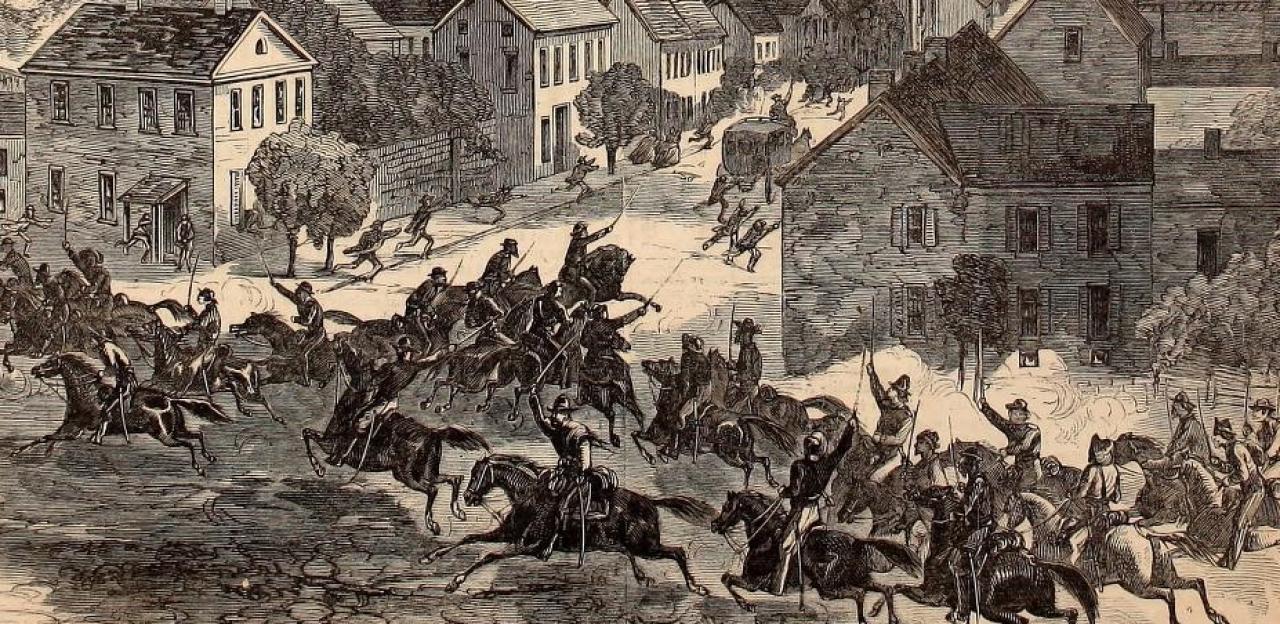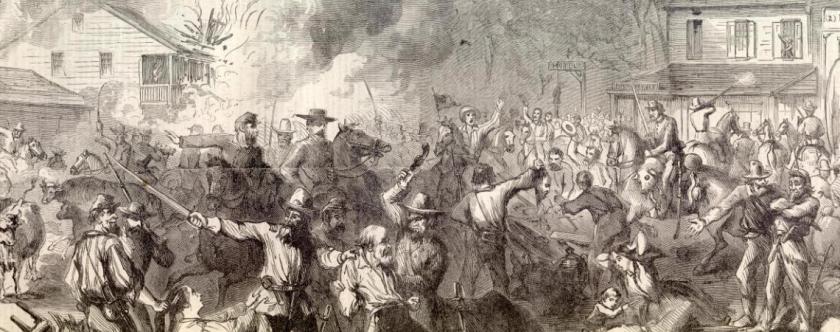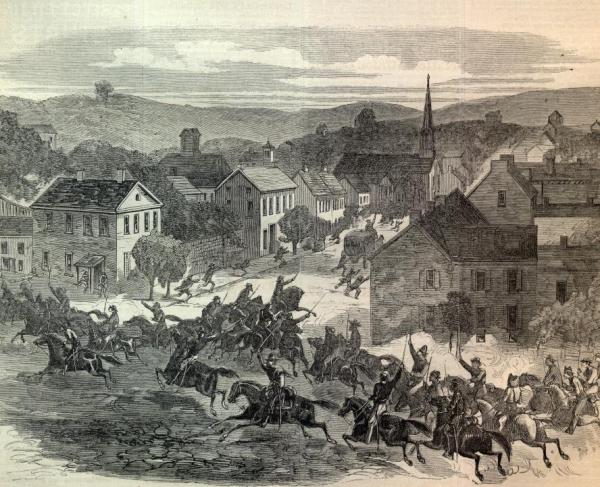Morgan's Great Raid of 1863

In the summer of 1863, things were looking very bleak for the Confederate armies in the field with battles and campaigns like Gettysburg, Vicksburg, and Tullahoma souring the Confederate morale quickly. One Confederate cavalier, in the midst of these horrible setbacks, decided to launch one of the most daring raids of the Civil War, a raid that would span hundreds of miles from Tennessee to Ohio.
During the spring and early summer of 1863, Confederate Brigadier General John H. Morgan was a seasoned raider with at least three very successful Kentucky raids under his belt. Gen. Morgan now was itching for another raid, one that would cement him in his growing fame. Spending the winter of 1862 planning and strategizing for this raid, the time finally came in June of 1863 to begin. The first obstacle in his way was convincing his superiors Generals Joe Wheeler and Braxton Bragg. Both men wanted Morgan to raid into the Bluegrass State, but stressed several times for Morgan to stay in Kentucky, and if possible, make a definitive move on Louisville. Morgan, wanting to get a start on his raid, agreed, but things would change once Morgan was away from the peering eyes of his superiors.
Morgan’s 2,500 men cavalry division was divided up into two separate brigades with both commanded by seasoned officers. The first brigade was commanded by his brother-in-law Colonel Basil W. Duke. The second brigade was commanded by Colonel Adam R. Johnson, known commonly as Stovepipe Johnson. Both brigades were supported by one artillery battery with 2 guns attached to each brigade, as well as seasoned veterans - many of whom were involved with Morgan’s earlier successful raids. With his brigades ready, Morgan began what would become known as the Great Raid. Beginning in early June of 1863, Morgan’s brigades slowly made their way north, from Sparta, Tennessee, towards the Cumberland River. Mother nature, however, slowed Morgan’s men down with heavy rains flooding the dirt roads - not to mention Duke’s brigade had been sent on a mission in eastern Tennessee. Nevertheless, by the 1st of July, Morgan’s brigades began to cross the river in mass, many using ferries located all along the river. These crossings did not go unnoticed by the Federal patrols along the river, and in several cases, they led to small but intense skirmishes, one of which would have a profound impact on the rest of the Great Raid. Near Norris Branch, Kentucky, on July 2nd, Captain Quirk, the leader of an elite scouting company in Morgan’s division dubbed “Quirks Scouts”, led his men in a small skirmish resulting in him receiving a debilitating wound and knocking him out for the rest of the raid. Captain Jacob T. Cassell took command of the company.

The larger Federal forces in the area, men of the XXIII Corps, were aware of Morgan’s crossings. However, the fog of war set in almost as Morgan began to cross. In one instance, Brigadier General Edward Henry Hobson, a Kentuckian, and a key player in the great raid, believed that Morgan’s men were more than likely to cross the Cumberland River near the Burkesville area in Cumberland County. His superior, General Henry M. Judah, did not and would not believe Morgan was going to cross in that area, but instead believed they would cross 10 miles to the east. This move opened the door for Morgan’s men to cross the river into Kentucky without any serious threat.
Once Morgan’s men made their way across the Cumberland River, the race to outrun the Union was on. For weeks Morgan’s men saw constant combat, running from Federal forces, and suffered constant fatigue. Morgan and his raiding party's first taste of victory came on July 3 when the leading regiments of the first brigade, under Duke, attacked and quickly pushed away a small force of 150 Federals in the town of Columbia, Kentucky. However, they suffered a devastating loss with Capt. Cassell was severely wounded and a green leader, Captain Tom Franks, had to assume command. After taking over the small Kentucky town, Morgan’s men moved on north towards Taylor County. The next morning, on July 4, the division fought its first major battle of the Great Raid in the Battle of Tebbs Bend. Here a small force of less than 200 untested Federal soldiers of the 25th Michigan whipped Morgan’s 2,500 men division. Not only did Morgan lose many men, he lost many irreplaceable junior and senior officers like David W. Cheanult who would be sorely missed in the coming weeks. After failing to dislodge the Federals, Morgan’s command moved around them and pushed on to Campbellsville then on towards Lebanon. The following day his men fought in a vicious street battle with a mixed force of 400 or so Federals under the command of Col. Charles Hanson. During this urban warfare, one of Morgan’s brothers, Tom, was killed which deeply struck a nerve with Morgan and led him to tell Col. Hanson, who was a childhood friend, to go home and tell mother he killed Tom. Morgan continuously lost many promising junior officers as well as Capt. Tom Franks, then the commander of Quirks Scouts. After the battle had ceased in the late afternoon on July 5, Morgan’s Raiders continued on towards the direction of Bardstown, Kentucky.
By this point, Federal forces in the state were organizing commands to pursue Morgan. Brig. Gen. Hobson, who was able to guess correctly where the rebels were going to cross, was given the lead command of a brigade of cavalry and artillery but was at least a full day's ride from Morgan’s cavalry. Over the next two days, Morgan’s men made their way from Bardstown, in Nelson County, to Bardstown Junction, in Bullitt County, where he learned through George A. Lightning Ellsworth, that the Federals believed he was going to attack Louisville. Morgan then sent a diversionary force around Louisville and instead headed towards his crossing point at Brandenburg, Kentucky. The town was located along the Ohio River and offered a safe place to cross because no Federal force was garrisoned close to the area. His men on July 7 captured two steamboats - the McCombs and the Alice Dean. On the 8th, as his men began to cross the mighty Ohio River, all went well for a few hours until Federal forces began to zero in on the area. For the rest of the day, Morgan’s rearguard and artillery batteries held the Federals at bay while the rest of the men crossed. After the crossing was completed, the Alice Dean was burned and the McCombs was saved due to a friendship between Col. Duke and the captain of the boat.
By July 9, Morgan’s men were in Indiana, yet the enjoyment of their crossing would not last long. The men had to move north to Corydon, Indiana where Morgan’s division - now around 2,200 men - faced off against a small force of about 400 Indiana Legion men. In the battle, the legion was eventually routed from the field and the Confederates captured the town. The rebels did not stay for long, now deep in enemy territory, the men had to move at a constant speed or risk begin killed or captured. The next day, Morgan’s men captured Salem, Indiana and about 500 legion men. Next, they moved on towards Vienna, Indiana where the command halted for a time. Here they tapped into the telegraph wires and learned new information on Federal whereabouts, including Hobson who was now trailing Morgan’s rear.
By late evening on July 11, Morgan’s division was just outside of Vernon, Indiana where he met a force of about 2,000 Hoosiers under the command of Gen. Love. Love was asked by Morgan two times to surrender, each time refusing, and in turn, asked Morgan to surrender. Morgan, realizing a fight was fruitless, decided to ride around the city and head east towards Dupont, Indiana. The Federals, and the militia, did not realize this until the following morning. By that point, it was too late for the doomed city. Morgan’s men destroyed the railroad bridges in the area, cut telegraph wires, stole clothes, shoes, food, and much more. By early the next morning on July 12, Morgan’s men left the area heading east towards Ohio. Brig. Gen. Hobson’s force came into the town only 6 hours later. Morgan, by mid-day on July 13, was only a few miles away from the Ohio border. However going into Ohio was no easy task, as Morgan knew he had to ride around Cincinnati, which from several reports had turned into a large fortress, as well as evade Hobson’s rapid pace in the rear. In order to give his men valuable time, he burned the White River Bridge, which delayed pursuing union forces for several hours. The first Ohio town his men reached was Harrison and just like every town they came upon, Morgan’s raiders liberated anything they wanted - clothing, food, valuables, or animals from the local populous. On July 14 Morgan’s division separated after passing through Glendale, Ohio, as Duke’s command went through Montgomery while Morgan’s command moved on Camp Denson was in vain Morgan tried to collect horses and equipment from the camp. Unexpectedly, they found 600 entrenched soldiers there. Deciding it was not worth the time nor the loss of life, he bypassed the camp and moved to the Little Miami River Bridge where he found a small force of federals. In a small hour-long fight Morgan’s men were denied crossing and moved two miles upstream. Both commands were reunited once across the river and then moved towards Williamsburg, Ohio. Upon reaching the town the men were allowed to rest, the command had completed their goal of nonstop riding for 35 hours making an impressive 95-mile ride. Morgan’s force was now down to 1,900 men, starting the raid with around 2,500. Hobson’s force in the meantime was not far behind, as he stopped his command at nightfall only 15 miles away in Newberry. Both commands awoke the next day on July 15 and began the chase again. Hobson’s force by this point consisted of about 3,000 men. Morgan’s goal now was to make it Buffington Island where he hoped to cross the large sand bar in the Ohio River and make his way into West Virginia and on southward. For the next several days, his men continually burned bridges, commandeered horses, confiscated food, and generally terrorized the local Ohioans.
By July 18, Morgan had made it to Rutland, Ohio. His men after a few hours rest, pressed on towards Buffington Island, but not before fighting off militia at Middleport. Morgan’s raiders finally made it into the Portland area, not more than a few miles away from Buffington Island, during the night. Eventually, the men made their way to the shores of the Ohio in the Buffington Island area. What Morgan did not know, however, was that thousands of Federal forces were now moving into the area. Hobson, along with other Union forces, were coming up to his rear. Naval gunboats patrolled up and down the Ohio River's shoreline, and more troops were positioned along the West Virginia shore. Morgan was unequivocally boxed in and was forced to go on the defense. The Battle of Buffington Island was the final engagement to the end of a long-reaching raiding campaign that began in the early morning around 5:30 am, on July 19. Morgan’s men numbered less than 1,800 strong and now faced over 3,000 men all under the command of Brig. Gen Hobson. In the approximately 4-hour long fight, Morgan’s men were pushed back from their positions along the hills near Buffington Island. Very quickly, the situation turned from bad to worse with the Rebels becoming confused and scurrying everywhere. In the confusion that followed, Morgan was able to retreat with only a few hundred men, and the majority of his men were captured while less than 100 were killed or wounded. Only a few bands of men were able to cross the Ohio, with Adam R. Johnson being one of them. Morgan and his small band only lasted a few days longer, surrendering at West Point, Ohio on July 26. Morgan’s Great raid lasted a short three and half weeks, but trekked an impressive 1,000 miles. The Raid itself cost the Union hundreds of thousands of dollars in damages, not only in military property but civilian property as well. His once formidable brigade of raiders, horse thieves, and cavaliers were forever destroyed after the Great Raid. After escaping imprisonment with some of his fellow raiders, Morgan's subsequent raids were not nearly as large scale as his Great Raid due to General Bragg's distrust in him. After his appointment to the Trans-Allegheny Department, Morgan was killed in a Union cavalry ambush on September 2, 1864, in Greeneville, Tennessee.
Further Reading:
- Morgan is Coming, Confederate Raiders in the Heartland of Kentucky By: Betty J. Gorin
- The Longest Raid of the Civil War By: Horwitz V. Lester
- Morgan's Great Raid: The Remarkable Expedition from Kentucky to Ohio (Civil War Series) By: David L. Mowery
Related Battles
55
1,175



